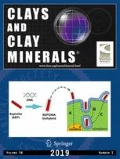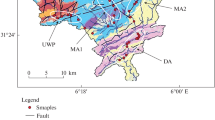Abstract
Despite the numerous studies on geomaterials in Tunisia, quite a few clay varieties are not yet well defined. In fact no detailed geological, mineralogical, or geochemical characterizations of Tunisian palygorskite deposits have been carried out to date. The purpose of the present work was to study the continental Eocene clay deposit at the southern end of the Tunisian North axis, between Jebel Rheouis and Jebel Boudinar, to determine its potential as a clay reserve. Nine samples were collected from the Cherahil formation representing the lower, middle, and upper levels. The analytical results obtained using several techniques (chemical analysis, X-ray diffraction, specific surface area measurements, Fourier-Transform infrared spectroscopy, scanning electron microscopy) revealed that palygorskite is the dominant clay mineral. Dolomite and quartz are present as associated minerals. Chemical analysis of sample AR9 showed a smaller potassium content compared to other samples. Sample AR9 consists essentially of dolomite associated with palygorskite and quartz. Other samples (AR5, AR6, and AR7) collected from the same Cherahil formation contained palygorskite as the main phyllosilicate mineral (80%). The important reserve of palygorskite was found in the middle of the Cherahil formation. Dolomite and quartz associated with palygorskite reduced the length and crystallinity of the fibrous clay morphology. Analysis by scanning electron microscopy proved that the crystallinity of palygorskite was less in the lower and upper parts of the Cherahil formation. The central palygorskite deposit may be of interest for pharmaceutical (adsorbent drug) and other applications. The two other levels of Cherahil formation are mineralogically heterogeneous and considered economically less important than the middle level, which is rich in palygorskite.








Similar content being viewed by others
REFERENCES
Abdeljaoued, S. (1983). Étude sédimentologique et structurale de la partie est de la chaîne nord des Chotts (Tunisie méridionale). Thèse, Université de Tunis, 148 pp.
Abdeljaoued, S. (1991). Les dolocrètes et les calcrètes du Paléocène– Éocène, Tunisie méridionale. Thèse d’État, Université de Tunis, 2, 242 pp.
Abdeljaoued, S. (1997). Mode de genèse des palygorskites dans la série continentale éocène de Tunisie méridionale. Notes du Service géologique, Tunisie, 63, 15–27.
Affouri, A., Eloussaief, M., Kallel, N., & Benzina, M. (2015). Application of Tunisian limestone material for chlorobenzene adsorption: characterization and experimental design. Arabian Journal of Geoscience, 8, 11183–11192.
Ashraf, M. A., Hussain, I., Rasheed, R., Iqbal, M., Riaz, M., & Arif, M. S. (2017). Advances in microbe-assisted reclamation of heavy metal contaminated soils over the last decade: a review. Journal of Environmental Management, 198, 132–143.
Bédir, M. (1995). Mécanismes géodynamiques des bassins associés aux couloirs de coulissement de la marge Atlasique de la Tunisie. Séismo-stratigraphie, séismo-tectonique et implications pétrolières, Thèse d’État, université de Tunis, 2, 407.
Benzina, M. (1990). Kinetic study and thermodynamic of organic adsorption onto local clays, Modelling adsorbant on bed fixed. Thesis of Doctorat of Physic Sciences, Faculty of Sciences of Tunis, 25.
Boukadi, N., & Bédir, M. (1996). L’halocinèse en Tunisie: contexte tectonique et chronologie des événements, C. R. Académie des Sciences. Paris, série IIa, 322, 587–594.
Brunauer, S., Deming, L. S., Deming, W. E., & Teller, E. (1940). On a theory of the van der Waals adsorption of gases. Journal of American Chemical Society, 62, 1723.
Burollet, P. F. (1956). Contribution à l’étude stratigraphique de la Tunisie centrale. Annales des Mines et de la Géologie, Tunis, 18, 1–350.
Cagatay, M. N. (1990). Palygorskite in the Eocene rocks of the dammam dome, Saudi Arabia. Clays and Clay Minerals, 38, 299–307.
Draidia, S., El Ouahabi, M., Daoudi, L., Havenith, H. B., & Fagel, N. (2016). Occurrences and genesis of palygorskite/sepiolite and associated minerals in the Barzaman formation, United Arab Emirates. Clay Minerals, 51, 763–779.
Eloussaief, M., Bouaziz, S., Kallel, N., & Benzina, M. (2013a). Valorisation of El Haria clay in the removal of arsenic from aqueous solution. Desalination Water Treatment, 52, 2220–2224.
Eloussaief, M., Kallel, N., Yaacoubi, A., & Benzina, M. (2011). Mineralogical identification, spectroscopic characterization, and potential environmental use of natural clay materials on chromate removal from aqueous solutions. Chemical Engineering Journal, 168, 1024–1031.
Eloussaief, M., Sdiri, A., & Benzina, M. (2013b). Modelling the adsorption of mercury onto natural and aluminium pillared clays. Environmental Science Pollution Research, 20, 469–479.
Felhi, M., Tlili, A., Gaied, M. E., & Montacer, M. (2008). Mineralogical study of kaolinitic clays from Sidi El Bader in the far north of Tunisia. Applied Clay Science, 39, 208–217.
Frost, R. L., Locos, O. B., Ruan, J., & Kloprogge, J. T. (2001). Near-infrared and mid-infrared spectroscopic study of sepiolites and palygorskites. Vibrational Spectroscopy, 27, 1–3.
Garcia-Romero, E., Suarez, M., Santaren, J., & Alvarez, A. (2007). Crystallochemical characterization of the palygorskite and sepiolite from the Allou Kagne deposit, Senegal. Clays and Clay Minerals, 55, 606–617.
Ghnainia, L., Eloussaief, M., Zouari, K., & Abbes, C. (2016). Wastewater treatment in petroleum activities: example of “SEWAGE” unit in the BG Tunisia Hannibal plant. Applied Petrochemical Research, 6, 155–162.
Ghrab, S., Boujelben, N., Medhioub, M., & Jamoussi, F. (2014). Chromium and nickel removal from industrial wastewater using Tunisian clay. Desalination Water Treatment, 52, 2253–2260.
Ghrab, S., Eloussaief, M., Lambert, S., Bouaziz, S., & Benzina, M. (2017). Adsorption of terpenic compounds onto organo-palygorskite. Environmental Science Pollution Research, 25, 18251–18261.
Hafez, A. I., Naser, S. G., Ibrahim, H. N., Abou El-magd, W. S. I., & Hashem, A. (2016). Evaluation of kaolin clay as natural material for transformer oil treatment to reduce the impact of ageing on copper strip. Egyptian Journal of Petroleum, 26, 533–539.
Jamoussi, F., Abbès, C., Fakhfakh, E., Bédir, M., Kharbachi, S., Soussi, M., Zargouni, F., & López-Galindo, A. (2001). Découverte de l’Éocène continental autour de l’archipel de Kasserine, aux Jebels Rhéouis, Boudinar et Chamsi en Tunisie centro-méridionale: nouvelles implications paléogéographiques. Comptes Rendus d’académie des Sciences -Série IIA-Earth and Planetary Science, 333, 329–335.
Jamoussi, F., Bédir, M., Boukadi, N., Kharbachi, S., Zargouni, F., López-Galindo, A., & Paquet, H. (2003). Evolution minéralogique des argiles et contrôle tectono-eustatique des bassins de la marge Tunisienne. Geoscience, Géomatériaux / Geomaterials, 335, 175–183.
Jarraya, I., Fourmentin, S., Benzina, M., & Bouaziz, S. (2011). The characterization of prepared organoclay materials (ddma) and gas sorption of chlorobenzene. The Canadian Journal of Chemical Engineering, 89, 392–400.
Jemaï, M. B. M., Sdiri, A., Ben Salah, I., Ben Aissa, L., Bouaziz, S., & Duplay, J. (2017). Geological and technological characterization of the Late Jurassic-Early Cretaceous clay deposits (Jebel Ammar, northeastern Tunisia) for ceramic industry. Journal of African Earth Science, 129, 282–290.
Kadri, A., Matmati, F., Ben Ayed, N., & Ben Haj Ali, M. (1986). Découverte de l’Éocène inférieur continental au Jebel Lessouda (Tunisie centrale). Notes du Service géologique, Tunisie, 51, 53–59.
Khiari, I., Mefteh, S., Sánchez-Espejo, R., Cerezo, P., Aguzzi, C., López-Galindo, A., Jamoussi, F., & Viseras Iborra, C. (2014). Study of traditional Tunisian medina clays used in therapeutic and cosmetic mud-packs. Applied Clay Science, 101, 141–148.
Martín-Ramos, J. (2004) D. X-Powder, a software package for powder X-ray diffraction analysis. Legal Deposit G.R.1001/04, http://www.xpowder.com.
Mefteh, S., Khiyari, I., Sanchez-Espejo, R., Aguzzi, C., Lopez Galindo, A., Jamoussi, F., & Viseras, C. (2014). Characterisation of Tunisian layered clay materials to be used in semisolid health care products. Materials Technology Journal, 29, B88–B95.
Mkaouara, S., Maherzib, W., Pizette, P., Zaitan, H., & Benzina, M. (2019). A comparative study of natural Tunisian clay types in the formulation of compacted earth blocks. Journal of African Earth Science, 160, 103620.
Park, Y., Godwin, A., Ayoko, & Frost, R. L. (2011). Characterization of organoclays and adsorption of p-nitrophenol: Environmental application. Journal of Colloid and Interface Science, 360, 440–456.
Qiu, G., Xie, Q., Liu, H., Chen, T., Xie, J., & Li, H. (2015). Removal of Cu (II) from aqueous solutions using dolomite–palygorskite clay: Performance and mechanisms. Applied Clay Science, 118, 107–115.
Sassi, S., Triat, J.-M., Truc, G., & Millot, G. (1984). Découverte de l’Éocène continental en Tunisie centrale: la formation du Djebel Gharbi et ses encroûtements carbonatés, C. R. Académie des Sciences. Paris, série II, 299, 357–364.
Sdiri, A., Higashi, T., Hatta, T., Jamoussi, F., & Norio, T. (2010). Mineralogical and spectroscopic characterization, and potential environmental use of limestone from the Abiod formation, Tunisia. Environmental Earth Science, 61, 1275–1287.
Soong, R. (1992). Palygorskite occurrence in northwest Nelson, South Island, New Zealand. Journal of Geology and Geophysics, 35, 325–330.
Tlili, A., Felhi, M., & Montacer, M. (2010). Origin and depositional environment of palygorskite and sepiolite from the Ypresian phosphatic series, Southwestern Tunisia. Clays and Clay Minerals, 58, 573–581.
Xu, J., Wang, W., & Wang, A. (2014). Effect of squeeze, homogenization, and freezing treatments on particle diameter and rheological properties of palygorskite. Advanced PowderTechnology, 25, 968–977.
Yuan, X., Li, C., Guan, G., Liu, X., Xiao, Y., & Zhang, D. (2007). Synthesis and characterization of polyethylene terephthalate/attapulgite nanocomposites. Journal of Applied Polymer Science, 103, 1279–1286.
Zha, F., Huang, W., Wang, J., Chang, J., Ding, J., & Ma, J. (2013). Kinetic and thermodynamic aspects of arsenate adsorption on aluminum oxide modified palygorskite nanocomposites. Chemical Engineering Journal, 215–216, 579–585.
Zhang, Y., Wang, W., Zhang, J., Liu, P., & Wang, A. (2015). Comparative study about adsorption of natural palygorskite for methylene blue. Chemical Engineering Journal, 262, 390–398.
Zhu, Y., Chen, T., Liu, H., Xu, B., & Xie, J. (2016). Kinetics and thermodynamics of Eu(III) and U(VI) adsorption onto palygorskite. Journal of Molecular Liquids, 219, 272–278.
Zouari, H. (1984). Étude structurale du Jebel Chaambi (Tunisie centrale) Relation entre la minéralisation et la structure. Thèse 3e cycle, Université de Franche-Comté, Besançon, 93.
ACKNOWLEDGMENTS
The authors are grateful to Prof. Abdelmajid Dammak for his checking of the English in the manuscript.
Author information
Authors and Affiliations
Corresponding author
Ethics declarations
CONFLICT OF INTEREST
We confirm that there are no known conflicts of interest associated with this publication and there has been no significant financial support for this work that could have influenced its outcome.
Rights and permissions
About this article
Cite this article
Allouche, F., Eloussaief, M., Ghrab, S. et al. CLAY MATERIAL OF AN EOCENE DEPOSIT (KHANGUET RHEOUIS, TUNISIA): IDENTIFICATION USING GEOCHEMICAL AND MINERALOGICAL CHARACTERIZATION. Clays Clay Miner. 68, 262–272 (2020). https://doi.org/10.1007/s42860-020-00062-0
Published:
Issue Date:
DOI: https://doi.org/10.1007/s42860-020-00062-0




